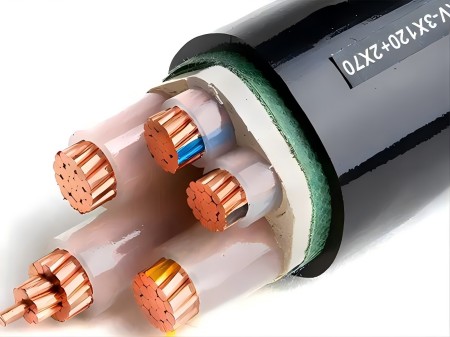Crosslinked polyethylene insulated power cable is widely used in power system because of its good thermal and mechanical properties, excellent electrical properties and chemical corrosion resistance. It also has the advantages of simple structure, light weight, laying is not limited by the drop, and is widely used in urban power grids, mines, chemical plants and other scenes. The insulation of the cable uses cross-linked polyethylene, which is chemically converted from linear molecular polyethylene into a three-dimensional network structure, thereby greatly improving the mechanical properties of polyethylene while maintaining its excellent electrical properties. The following details the differences and advantages between crosslinked polyethylene insulated cables and ordinary insulated cables from many aspects.
1. Material differences
(1) Temperature resistance
The temperature rating of ordinary insulated cables is usually 70°C, while the temperature rating of cross-linked polyethylene insulated cables can reach 90°C or higher, significantly improving the heat resistance of the cable, making it suitable for more harsh working environments.
(2) Carrying capacity
Under the same conductor cross-sectional area, the current carrying capacity of the XLPE insulated cable is significantly higher than that of the ordinary insulated cable, which can meet the power supply system with large current requirements.
(3) Scope of application
Common insulated cables will release toxic HCl smoke when burned, and cannot be used in scenarios requiring environmental fire prevention and low toxicity. The cross-linked polyethylene insulated cable does not contain halogen, more environmentally friendly, suitable for distribution networks, industrial installations and other scenarios requiring large capacity electricity, especially AC 50Hz, rated voltage 6kV ~ 35kV fixed laying transmission and distribution lines.
(4) Chemical stability
Crosslinked polyethylene has good chemical resistance and can maintain excellent performance in the environment of acids, alkalis and other chemicals, which makes it more suitable for use in special scenarios such as chemical plants and Marine environments.
2. Advantages of cross-linked polyethylene insulated cable
(1) Heat resistance
Crosslinked polyethylene is modified by chemical or physical means to convert the linear molecular structure into a three-dimensional network structure, which greatly improves the heat resistance of the material. Compared to ordinary polyethylene and polyvinyl chloride insulation, crosslinked polyethylene cables are more stable in high temperature environments.
(2) Higher operating temperature
The conductor’s rated operating temperature can reach 90 ° C, which is higher than that of traditional PVC or polyethylene insulated cables, thus significantly improving the cable’s current carrying capacity and long-term operating safety.
(3) Superior mechanical properties
The crosslinked polyethylene insulated cable still has good thermo-mechanical properties at high temperature, better heat aging performance, and can maintain mechanical stability in a high temperature environment for a long time.
(4) Light weight, convenient installation
The weight of the cross-linked polyethylene insulated cable is lighter than that of ordinary cables, and the laying is not limited by the drop. It is especially suitable for complex construction environments and large-scale cable installation scenarios.
(5) Better environmental performance:
The cross-linked polyethylene insulated cable does not contain halogen, does not release toxic gases during combustion, has little impact on the environment, and is especially suitable for places with strict requirements for environmental protection.
3. Advantages in installation and maintenance
(1) Higher durability
Crosslinked polyethylene insulated cable has higher anti-aging performance, suitable for long-term buried laying or exposure to outdoor environment, reducing the frequency of cable replacement.
(2) Strong insulation reliability
The excellent insulation properties of crosslinked polyethylene, with high voltage resistance and breakdown strength, reduce the risk of insulation failure in high voltage applications.
(3) Lower maintenance costs
Due to the corrosion resistance and aging resistance of crosslinked polyethylene insulated cables, their service life is longer, reducing daily maintenance and replacement costs.
4. Advantages of new technical support
In recent years, with the improvement of crosslinked polyethylene material technology, its insulation performance and physical properties have been further improved, such as:
Enhanced flame retardant, can meet the special areas (such as subway, power station) fire requirements;
Improved cold resistance, still stable in extreme cold environment;
Through the new crosslinking process, the cable manufacturing process is more efficient and more environmentally friendly.
With its excellent performance, cross-linked polyethylene insulated cables occupy an important position in the field of power transmission and distribution, providing a safer, more reliable and environmentally friendly choice for modern urban power grids and industrial development.
Post time: Nov-27-2024


